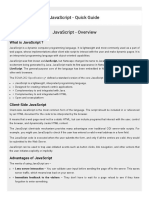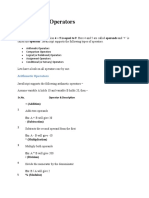JavaScript - Overview
Uploaded by
survivalofthepolyJavaScript - Overview
Uploaded by
survivalofthepolyJavaScript - Overview
What is JavaScript ?
JavaScript is a dynamic computer programming language. It is lightweight and most commonly
used as a part of web pages, whose implementations allow client-side script to interact with the
user and make dynamic pages. It is an interpreted programming language with object-oriented
capabilities.
JavaScript was first known as LiveScript, but Netscape changed its name to JavaScript, possibly
because of the excitement being generated by Java. JavaScript made its first appearance in
Netscape 2.0 in 1995 with the name LiveScript. The general-purpose core of the language has
been embedded in Netscape, Internet Explorer, and other web browsers.
The ECMA-262 Specification defined a standard version of the core JavaScript language.
JavaScript is a lightweight, interpreted programming language.
Designed for creating network-centric applications.
Complementary to and integrated with Java.
Complementary to and integrated with HTML.
Open and cross-platform
Client-Side JavaScript
Client-side JavaScript is the most common form of the language. The script should be included
in or referenced by an HTML document for the code to be interpreted by the browser.
It means that a web page need not be a static HTML, but can include programs that interact with
the user, control the browser, and dynamically create HTML content.
The JavaScript client-side mechanism provides many advantages over traditional CGI server-
side scripts. For example, you might use JavaScript to check if the user has entered a valid e-mail
address in a form field.
The JavaScript code is executed when the user submits the form, and only if all the entries are
valid, they would be submitted to the Web Server.
JavaScript can be used to trap user-initiated events such as button clicks, link navigation, and
other actions that the user initiates explicitly or implicitly.
Advantages of JavaScript
The merits of using JavaScript are −
Less server interaction − You can validate user input before sending the page off to the
server. This saves server traffic, which means less load on your server.
Immediate feedback to the visitors − They don't have to wait for a page reload to see if
they have forgotten to enter something.
Increased interactivity − You can create interfaces that react when the user hovers over
them with a mouse or activates them via the keyboard.
Richer interfaces − You can use JavaScript to include such items as drag-and-drop
components and sliders to give a Rich Interface to your site visitors.
Limitations of JavaScript
We cannot treat JavaScript as a full-fledged programming language. It lacks the following
important features −
Client-side JavaScript does not allow the reading or writing of files. This has been kept
for security reason.
JavaScript cannot be used for networking applications because there is no such support
available.
JavaScript doesn't have any multi-threading or multiprocessor capabilities.
Once again, JavaScript is a lightweight, interpreted programming language that allows you to
build interactivity into otherwise static HTML pages.
JavaScript Development Tools
One of major strengths of JavaScript is that it does not require expensive development tools. You
can start with a simple text editor such as Notepad. Since it is an interpreted language inside the
context of a web browser, you don't even need to buy a compiler.
To make our life simpler, various vendors have come up with very nice JavaScript editing tools.
Some of them are listed here −
Microsoft FrontPage − Microsoft has developed a popular HTML editor called
FrontPage. FrontPage also provides web developers with a number of JavaScript tools to
assist in the creation of interactive websites.
Macromedia Dreamweaver MX − Macromedia Dreamweaver MX is a very popular
HTML and JavaScript editor in the professional web development crowd. It provides
several handy prebuilt JavaScript components, integrates well with databases, and
conforms to new standards such as XHTML and XML.
Macromedia HomeSite 5 − HomeSite 5 is a well-liked HTML and JavaScript editor
from Macromedia that can be used to manage personal websites effectively.
Where is JavaScript Today ?
The ECMAScript Edition 5 standard will be the first update to be released in over four years.
JavaScript 2.0 conforms to Edition 5 of the ECMAScript standard, and the difference between
the two is extremely minor.
The specification for JavaScript 2.0 can be found on the following site:
http://www.ecmascript.org/
Today, Netscape's JavaScript and Microsoft's JScript conform to the ECMAScript standard,
although both the languages still support the features that are not a part of the standard.
You might also like
- Javascript For Beginners: Your Guide For Learning Javascript Programming in 24 HoursFrom EverandJavascript For Beginners: Your Guide For Learning Javascript Programming in 24 Hours3/5 (13)
- Javascript - Syntax: HTML Tags in A Web PageNo ratings yetJavascript - Syntax: HTML Tags in A Web Page3 pages
- Javascript Tutorial: Why To Learn JavascriptNo ratings yetJavascript Tutorial: Why To Learn Javascript138 pages
- What Is Javascript ?: Ecma-262 SpecificationNo ratings yetWhat Is Javascript ?: Ecma-262 Specification26 pages
- Quarter 3 Week 1 .Net2 Module Javascript PDFNo ratings yetQuarter 3 Week 1 .Net2 Module Javascript PDF17 pages
- Module 1 Lesson 4 JavaScipt Introduction VariablesNo ratings yetModule 1 Lesson 4 JavaScipt Introduction Variables45 pages
- What Is Javascript?: Thanks For Downloading. Enjoy The ReadingNo ratings yetWhat Is Javascript?: Thanks For Downloading. Enjoy The Reading24 pages
- Mysql - PHP Syntax: Mysql - Function (Value, Value,... )No ratings yetMysql - PHP Syntax: Mysql - Function (Value, Value,... )2 pages
- Javascript Tutorial: Why To Learn JavascriptNo ratings yetJavascript Tutorial: Why To Learn Javascript3 pages
- Mysql - Introduction: What Is A Database?No ratings yetMysql - Introduction: What Is A Database?2 pages
- HTML - Elements: Start Tag Content End TagNo ratings yetHTML - Elements: Start Tag Content End Tag2 pages
- PHP & XML: HTML List That's Not Valid XMLNo ratings yetPHP & XML: HTML List That's Not Valid XML3 pages
- PHP - Form Introduction: Dynamic WebsitesNo ratings yetPHP - Form Introduction: Dynamic Websites3 pages
- PHP - File Inclusion: The Include FunctionNo ratings yetPHP - File Inclusion: The Include Function2 pages
- PHP - Files & I/O: Opening and Closing FilesNo ratings yetPHP - Files & I/O: Opening and Closing Files4 pages
- PHP - Web Concepts: Identifying Browser & PlatformNo ratings yetPHP - Web Concepts: Identifying Browser & Platform5 pages
- Blend4Web For Humans by Christopher TopalianNo ratings yetBlend4Web For Humans by Christopher Topalian24 pages
- Chrowned: by An Extension: Abusing The Chrome Devtools Protocol Through The Debugger ApiNo ratings yetChrowned: by An Extension: Abusing The Chrome Devtools Protocol Through The Debugger Api15 pages
- Requirements Specification: Softwares UsedNo ratings yetRequirements Specification: Softwares Used2 pages
- How to reset password, add member, transfer ownership or reset profileNo ratings yetHow to reset password, add member, transfer ownership or reset profile14 pages
- Web App Security Browser Isolation: Mendel RosenblumNo ratings yetWeb App Security Browser Isolation: Mendel Rosenblum12 pages
- On - Page SEO Audit Report: Executive SummaryNo ratings yetOn - Page SEO Audit Report: Executive Summary4 pages
- ZN17 - MikhailEgorov - Neat - Tricks - To - Bypass - CSRF - ProtectionNo ratings yetZN17 - MikhailEgorov - Neat - Tricks - To - Bypass - CSRF - Protection38 pages
- Cnmaestro On-Premises 2.2.1 Release NotesNo ratings yetCnmaestro On-Premises 2.2.1 Release Notes7 pages
- New Perspectives on HTML 5 and CSS: Comprehensive 8th Edition Patrick M. Carey - Read the ebook online or download it for the best experience50% (2)New Perspectives on HTML 5 and CSS: Comprehensive 8th Edition Patrick M. Carey - Read the ebook online or download it for the best experience59 pages
- The Domino Designer Quickstart Tutorial1 61 70No ratings yetThe Domino Designer Quickstart Tutorial1 61 7010 pages






















































































































